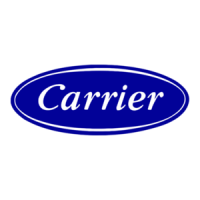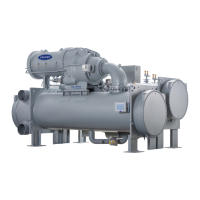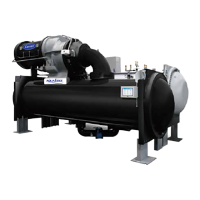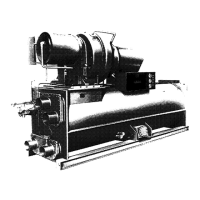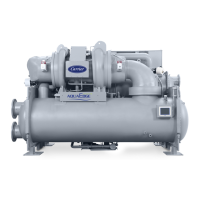2
DANGER
NEVER EXCEED specified test pressures. VERIFY the
allowable test pressure by checking the instruction literature
and the design pressures on the equipment nameplate.
DO NOT USE air for leak testing. Use only refrigerant or dry
nitrogen.
DO NOT VALVE OFF any safety device.
BE SURE that all pressure relief devices are properly installed
and functioning before operating any chiller.
THERE IS A RISK OF INJURY OR DEATH by
electrocution. High voltage may be present on the motor leads
even though the motor is not running. Open the power supply
disconnect before touching motor leads or terminals.
WARNING
Failure to follow these procedures may result in personal
injury or death.
DO NOT USE TORCH to remove any component. System
contains oil and refrigerant under pressure.
To remove a component, wear protective gloves and goggles
and proceed as follows:
a. Shut off electrical power to unit.
b. Recover refrigerant to relieve all pressure from sys-
tem using both high-pressure and low-pressure ports.
c. Traces of vapor should be displaced with nitrogen
and the work area should be well ventilated. Refriger-
ant in contact with an open flame produces toxic
gases.
d. Cut component connection tubing with tubing cutter
and remove component from unit. Use a pan to catch
any oil that may come out of the lines and as a gage
for how much oil to add to the system.
e. Carefully unsweat remaining tubing stubs when nec-
essary. Oil can ignite when exposed to torch flame.
DO NOT work on high-voltage equipment unless you are a
qualified electrician.
DO NOT WORK ON electrical components, including control
panels, switches, VFD, or oil heater until you are sure ALL
POWER IS OFF and no residual voltage can leak from
capacitors or solid-state components.
LOCK OPEN AND TAG electrical circuits during servicing.
IF WORK IS INTERRUPTED, confirm that all circuits are
de-energized before resuming work.
AVOID SPILLING liquid refrigerant on skin or getting it into
the eyes. USE SAFETY GOGGLES. Wash any spills from
the skin with soap and water. If liquid refrigerant enters the
eyes, IMMEDIATELY FLUSH EYES with water and
consult a physician.
DO NOT ATTEMPT TO REMOVE fittings, covers, etc.,
while chiller is under pressure or while chiller is running. Be
sure pressure is at 0 psig (0 kPa) before breaking any
refrigerant connection.
CAUTION
Failure to follow these procedures may result in personal
injury or damage to equipment.
TO AVOID an electric shock hazard, verify that the voltage on
the bus capacitors has discharged completely before servicing.
Check the DC bus voltage at the power terminal block by mea-
suring between the +DC and -DC terminals, between the +DC
terminal and the chassis, and between the -DC terminal and the
chassis. The voltage must be zero for all 3 measurements.
THE USER is responsible to conform with all applicable local,
national, and international codes. Failure to observe this
precaution could result in damage to, or destruction of, the
equipment.
THIS DRIVE contains ESD (electrostatic discharge) sensitive
parts and assemblies. Static control precautions are required
when installing, testing, servicing or repairing this assembly.
Component damage may result if ESD control procedures are
not followed. For static control procedures, reference
Rockwell publication Guarding Against Electrostatic Damage,
or any other applicable ESD protection handbook.
DO NOT alter the setting of any jumper without explicit
directions to do so. Failure to observe this precaution could
result in damage to, or destruction of, the equipment.
USE OF power correction capacitors on the output of the drive
can result in erratic operation of the motor, nuisance tripping,
and/or permanent damage to the drive. Remove power
correction capacitors before proceeding. Failure to observe this
precaution could result in damage to, or destruction of, the
equipment.
MOST CODES require that upstream branch circuit protection
be provided to protect input power wiring. If fuses are chosen
as the protection method, refer to the PowerFlex 755TL
Installation Instructions. Failure to observe this precaution
could result in damage to, or destruction of, the equipment.
DO NOT route signal and control wiring with power wiring in
the same conduit. This can cause interference with drive
operation. Failure to observe this precaution could result in
damage to, or destruction of, the equipment.
DISTRIBUTION SYSTEM short circuit capacity shall not
exceed the rating of the drive. Failure to observe this precau-
tion could result in damage to, or destruction of, the equip-
ment.
DO NOT STEP on refrigerant lines. Broken lines can whip
about and release refrigerant, causing personal injury.
DO NOT climb over a chiller. Use platform, catwalk, or
staging. Follow safe practices when using ladders.
USE MECHANICAL EQUIPMENT (crane, hoist, etc.) to lift
or move inspection covers or other heavy components. Even if
components are light, use mechanical equipment when there is
a risk of slipping or losing your balance.
BE AWARE that certain automatic start arrangements CAN
ENGAGE THE VFD, TOWER FAN, OR PUMPS. Open the
disconnect ahead of the VFD, tower fans, or pumps.
USE only repair or replacement parts that meet the code
requirements of the original equipment.
PERIODICALLY INSPECT all valves, fittings, and piping for
corrosion, rust, leaks, or damage.
DO NOT re-use compressor oil or any oil that has been
exposed to the atmosphere. Dispose of oil per local codes and
regulations.
DO NOT leave refrigerant system open to air any longer than
the actual time required to service the equipment. Seal circuits
being serviced and charge with dry nitrogen to prevent oil
contamination when timely repairs cannot be completed.

